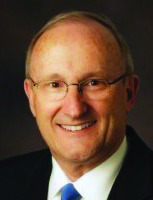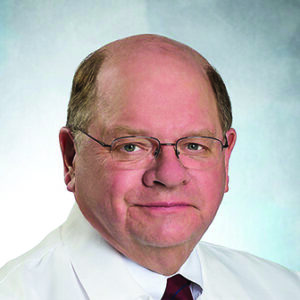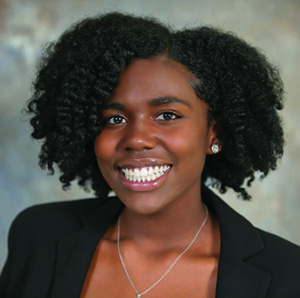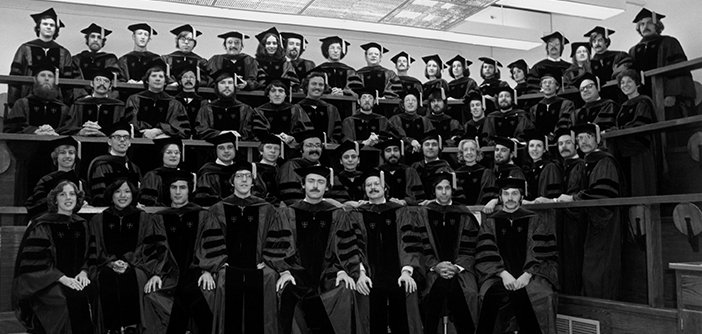In the 50th year of medical classes at Brown, alums look back as new students look forward.
On Brown’s first day of medical classes in the fall of 1972, Pardon Kenney ’72 MMSc’75 MD’75 RES’80, P’03 breathed “a great sigh of relief.”
The year before had been one of turmoil and worry. Kenney was then in his fourth year of a six-year program that would earn him bachelor’s and Master of Medical Science degrees; he’d matriculated in 1968 on the near-guarantee that, by the time he was ready to enter medical school, he’d be able to do so at Brown.
But by the fall of 1971, the promise had yet to be fulfilled. Many faculty strongly opposed the establishment of a medical school, arguing that it would dilute the undergraduate teaching mission, bankrupt the University, and “Brown would cease to exist,” Kenney recalls.
That was the backdrop against which students began their medical science classes, Kenney says: “There was a significant amount of uncertainty.”
As faculty and administration battled over their future, Kenney and his classmates did the only thing they could do: hunker down and get to work. Glenn Mitchell ’67 ScM’69 MD’75 RES’77, MPH, recalls their first day of classes in 1971 as one of anxiety and tension—due not to the politics swirling around them, but their anatomy lecture.
“We were all incredibly nervous because there was this gurney with a sheet over it and we knew: this was a body,” he says. “What happens if we faint? It would be really embarrassing!”

Glenn Mitchell
After months of debate, in March 1972 most of the faculty had been swayed: they voted 3-1 to approve the creation of an MD-granting program, which the Brown Corporation subsequently authorized. “It was a relief that we weren’t going to have to go shop for another place [to earn an MD], because we were loving it,” Mitchell says. “So it was a lot of gratitude to the Corporation for having said yes.”
And so it was, six months later, that not one, but two classes of medical students began classes at Brown: Mitchell and Kenney’s class, who were beginning their second year of medical studies; and the MD Class of 1976, who were starting their first. And all would earn a Doctor of Medicine from Brown University.
Kenney remembers the relief he felt as he returned to campus: “Now we’re bona fide, second-year medical students at a bona fide medical school. We could concentrate on actually learning.”
This fall marks the 50th anniversary of the first day of classes of Brown’s “bona fide” medical education program in the modern era. (A short-lived program in medical instruction existed at Brown in the early 1800s.) Over the past five decades, much of the new student experience has changed—but the core principles on which the program was founded have remained the same.
Something Old, Something New
“There’s nothing worse than an old doctor,” jokes Mitchell, a vice provost at Harrisburg University of Science and Technology who also trains emergency medicine residents at Penn State Health Hershey Medical Center. When he was a student, he laughs, “the older physicians … would go, ‘oh, it was better in the old days,’ and we would go, ‘yeah, sure.’ And now we all say, ‘it was better in our day,’ and all these medical students we talk to go, ‘oh yeah, sure.’”

Pardon Kenney
“Technology has obviously made a big difference,” says Kenney, a senior lecturer at Harvard Medical School, who recently stepped down as chief of surgery at the Brigham and Women’s Faulkner Hospital after 31 years. “What they’re teaching [now]is totally different—stuff we didn’t even know existed back then. … And the amount of knowledge they’re being asked to retain is light-years more than what was required of us.” He adds, “I tell students and residents today that half of what I learned in medical school was wrong, and the other half is obsolete.”
One thing that hasn’t changed—much—at Brown is the anatomy course. Fifty years later, students here are still dissecting cadavers, while many of their peers across the country learn anatomy via virtual tools, “which is sort of sad,” Kenney says.
In the 1970s, anatomy was “infamous” for its difficulty, he adds, and that’s still true today. Aja Tucker MD’26, now nearly a month into her medical student career, says that so far, “anatomy is probably one of the hardest classes, because it has new terms and material that I haven’t seen before, in comparison to other classes.”
The spaces where Brown’s medical students learn anatomy have, thankfully, evolved over 50 years. Mitchell’s first lecture took place in “a reproduction 16th-century Dutch amphitheater” in the basement of the BioMedical Center. “We all sat on these little stools in a very steep room and looked down” at the professor, he says.
As for anatomy lab, every student underwent the rite of passage of “smelling like formaldehyde,” Mitchell says; when they went to lunch at Faunce House, “no one would sit near us.” Meanwhile today’s students, after completing their work in the state-of-the-art anatomy lab on the third floor of the dedicated Warren Alpert Medical School building, they can take a shower and change their clothes in adjoining locker rooms.
Of that building, a short walk down College Hill in Providence’s Jewelry District, Kenney says: “It was a major conceptual leap for Brown to build teaching space away—not on the [main]campus. That’s a big difference for the students now. They identify the Medical School with that building.”
With more space have come more students. The MD Class of 1975 numbered 58, while the MD Class of 2026 has 144—more than twice as many. The class makeup has changed too: that first class was just 22 percent women, compared with 53 percent today; the earliest classes had almost no racial or ethnic diversity, while 27 percent of the new class is composed of students from backgrounds underrepresented in medicine.
There’s more geographic diversity as well: 50 years ago, nearly every medical student had earned their bachelor’s at Brown; now they hail from 57 different undergraduate institutions, and all over the country and the world. They apply to the Medical School via several paths that didn’t exist in 1972, like Brown’s Program in Liberal Medical Education, postbaccalaureate linkages, and the Early Identification Program (EIP), which admits promising Rhode Island residents from certain colleges in the state.
The School also has an EIP relationship with Tougaloo College, a historically Black college in Jackson, MS. It was through that route that Tucker—and her older sister, Nailah Tucker MD’24—came to Brown. “I literally followed her and did the same thing she did,” Aja Tucker laughs. Coming from Arlington, TX, she had expected a class of mostly New Englanders, but she’s met many fellow Texans and other Southerners. “It’s nice to know these people are also adjusting to living in the North,” she says.
The Human Touch

Aja Tucker
After years of anticipation, Tucker was so excited to finally arrive in Providence that on the first day of medical student orientation, “I showed up 30 or 40 minutes early,” she says. Only faculty were there, and they were excited to welcome her. But at the breakfast that morning (after everyone else showed up), “I was way too nervous to eat,” she says.
Tucker was quickly put at ease. She got to know some of her classmates, and listened to presentations on what to expect in the coming weeks, study strategies, and professionalism. “The deans … told us how they could support us and how they’re there for us,” she says. “It felt like they were in our corner, and I needed to hear that.”
Compassion and humanism marked medical education at Brown from day one. Kenney says students were drawn to a medical program that was “part of the larger fabric of the University” and included humanities courses. Faculty, meanwhile, came to Brown from other medical schools because “they saw an opportunity to do things in a different environment … to teach [medicine]in a fashion that was perhaps more humanistic even then,” he says. “That humanism, I think, has been a guiding principle for all of the classes that have graduated since.”
Mitchell remembers his anatomy professor, George “Erik” Erikson, MD, teaching them how to treat their cadavers with respect, “because this person had donated their body to medical training.” To this day, medical students honor those donors and their families with an annual Ceremony of Gratitude.
Tucker says her anatomy course director, Dale Ritter PhD’98, has helped her not only to better understand the material, but to adjust to life as a medical student. “He said, ‘I know medical school is hard and it’s gotten harder over the years.’” Ritter urged her to take care of herself, telling her, “It’s necessary to take time for yourself so you can succeed, and eventually become a doctor like you want to be,” Tucker says.
Of the faculty as a whole, she adds: “I love how they make sure that their students know that they’re here to support you … that no matter what you’re going through, if you feel like you’re overwhelmed, that they’re there.”
That’s certainly one thing that’s changed radically since Mitchell’s day—for the better. “We knew we were in for 14 to 18 hours a day of work,” he recalls. “There was no personal time, no family time. It was just brutal.”
Yet through it all, like students today, that first class felt supported and loved. Founding dean Stanley M. Aronson, MD, MPH, “was dad to most of us,” Mitchell says. Kenney adds, of their professors, “They bent over backwards to give us a great education.”




